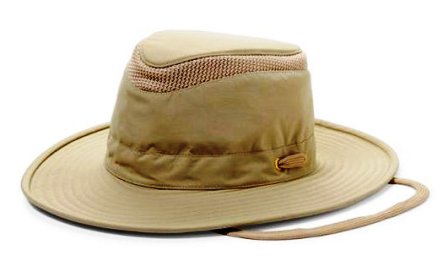Hello Friends,
Your response to our Annapurna and Everest luxury lodge treks with trip leader Peter Rudy this October has been rather overwhelming. With many of you asking questions on similar topics, Peter has decided to address the more frequently asked in a series of Top Tips. This “Top Tip” will cover ‘Must Have Clothing for any Trek in Nepal?” Future topics will include food on trek, how to get there, culture, keeping devices powered and more.
Whether you have already decided to join Peter in Nepal or still thinking about it, these Top Tips will help you prepare.

A Most Important item of Trek Clothing is Often the Most Overlooked: a wide brim hat.
Trip Leader Peter Rudy’s “Top Tips” Series
QUICK ANSWER: Yes, you really must bring a wide brim hiking hat. Sorry, a baseball cap will not do. Many consider the Tilley LTM6 one of the best wide brim hiking hats. Not cheap but it looks great, and it works. Tilley pretty much invented the wide brim outdoor hat half a century ago.
BIGGEST HAT COMPLAINT: After trekking a few days, at altitude, I often hear: my baseball cap is worthless, makes my head sweaty and my ears, nose and back of neck are burnt to a crisp.
Tip #1: Gotta Be Wide Brim. Google “wide brim hiking hat.” I got 4 million results. And yes, many of them years ago look a bit goofy. Years ago, they all did. But now, many do NOT! IF you pay attention to a few suggestions, a good hat can look good and do their job: protecting your head from the sun. If style is not important, there are many, not expensive wide brim hats from great outdoor clothing companies.
BUT WHY A WIDE BRIM:
• Sun protection for your head and neck – plain and simple. Perhaps you have seen that skin cancer is the fastest growing cancer. Why? We are living longer, we are outdoors more and apparently, a lot more UV rays are reaching us.
• Keeps you cooler. Wide brim bucket style hats that rest ON your head, with an air gap on the top, gives air circulation.
• It’s a physical barrier, unlike sun block cream. Takes no effort other than putting it on.
Tip #2: FIT COUNTS. Should Sit Loosely on Your Head. The typical bucket hat or fedora style hat “rests” on your head. A proper fitting wide brim hat should FALL OFF your head if you bend down and shake your head. Tilley says hats should stay on by gravity, not intense pressure that WILL DEFINITELY give you a headache. Worried about losing your hat in the wind? GOOD hiking hats have a cord in the brim to secure them in winds.
Tip #3: CHECK SUN PROTECTION. Not all hats are created equal. Good hats these days will state the sun protection. Tilley has certified to UPF50+. Do not assume! Some expensive hiking hats offer little sun protection. Quality clothing companies will state the sun protection.
Tip #4: SIZING ALSO COUNTS. Get one that fits. DUH! Tilley, Tilson and others have multiple sizes. I suggest not getting a hat that does not come in at least three or more sizes. Many of the cheapies on Amazon are “one size fits no one.” These tend to be a large with a big draw string. Think XXL sweat pants with a draw string.
Tip #5: PICK YOUR HAT IN PERSON. Would you buy hiking boots without trying on first? (Shame on you!) The same goes for your hiking hat. And let’s face it, trying on hiking hats is a lot easy than boots! REI has tons of hats, as do all the other outdoor shops. Tilley uses 1/8 inch size differences – they have tones of sizes. Even though Tilley has a great sizing guide on the web, nothing beats putting it on your head. (I wear a full size larger than the sizing guide says).
Tip #6: NOT COTTON. Should be obvious that cotton is not a great trekking fabric. The best trekking grade hats are nylon or polyester. You know the reasons: dry fast, stay cleaner.
Tip #7: GET REAL VENTILATION. The better (and more expensive) wide brim hiking hats have ventilation mesh around the top. IT WORKS! And still keeps the sun out. While big grommets let out hot air, they let in sun. Yes, it can lead to burns.
Tip #8: REINFORCED BRIM. Ok, now we are getting to the fine details. I prefer wide brim hats with some sort of wire or special stitching in the circumference of the brim. It keeps the brim horizontal and from looking like a floppy rag. BUT do not want to crush the brim. They can crease.
Tip #9: PACK YOUR HAT LAST. Two reasons: easily accessible with you land and prevents crushing. When a hat says it crushable, watch out. Perhaps ok for a rafting trip, but no crushable hat ever looked stylish. I lay my hat out flat on top of my clothes and press it flat. It prevents to brim from creasing.
Tip #10: CLEANING: If you wash your hat often, it will stay clean. Once a hiking hat gets seriously sweat stained, it will not come out. I hand wash, mild soap and leave it to dry over a gallon milk jug. With well made hats, you can take out wrinkles and resize by putting the hat over your knee and pulling.
AND FINALLY: Color matters but not for the reason you think. Off white and light khaki hats show dirt and even fingerprints. Studies show that hat colors do NOT make big differences in head temperature for the hats we should be hiking in: wide brim, bucket or fedora style hats that (1) fit loosely on top of your head and (2) have ventilation. One cool study (pun intended) placed the same hat of many colors on a bunch of melons in the sun. After several hours, they measured the core temperature inside the melon! Not much difference. Note: NOT true for baseball caps.
CLOSING THOUGHTS: Some may be thinking, how does this dude know so much about hats? Months ago, wife made me see a dermatologist for mole. Before the doctor says hello, she blurts out: your head is covered in precancerous cells (called AK’s). That was the bad news. Good news is that a simple cream, applied nightly for four weeks, kills them. So, I started reading up on what others like me have done after treatment. And found this great proverb: Been there, done that, got the hat!

